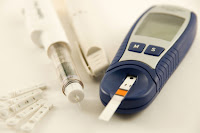Hyperlipidemia - Its simply means high lipid (fatty acids) levels in the blood. Hyperlipidemia is a sheer result of extremely high fat intake in the diet, lack of exercise, lack of adequate rest, inadequate fat metabolism in the body as a result of the earlier reasons. Lipids like triglycerides (TG), choline and lipoproteins whose levels rise in the blood due to improper fat metabolism of the adipose tissue that stores fat in the body and excessive fat intake in the diet. These lipids go on to form what we commonly term as cholesterol like LDL (bad), HDL (good), VLDL (extremely bad). A rise in blood lipids should be a warning sign at the first instance to cut down on fat and excessive simple sugars in your diet and regulate insulin levels in the blood. It would also indicate in patients suffering from diabetes of the unbalanced blood sugar levels.
Hypercholesterolemia (> 240 mg/dl) - The next step forward to attaining the good 'ol heart disease in diabetes is hypercholesterolaemia. As mentioned above the fatty acids like TG combine with lipoproteins, choline to form a very low density lipoproteins or VLDL. A rise in either TGs or VLDLs is a strong indicator of a possible hypercholesterolaemia in the next 48 hours or more as these go on to form low density lipoproteins or LDL. If the TGs and VLDLs are well within levels they will form high density lipoproteins or HDL (we all have known it is the good cholesterol). Whether the body has more HDL to LDL ratio or less will determine if it goes into hypercholesterolaemia. The standard acceptable ratio of Total cholesterol : HDL is less than 5:1.
Hypertension - With the progression of high cholesterol in the blood hypertension or high blood pressure is not far behind. Hypertension would be influenced by many factors like high blood viscosity due to high blood sugar & high cholesterol levels. But majorly the high blood pressure is the outcome of the hardened and constricted arteries due to cholesterol plaques near the heart. This hypertension in turn puts even more pressure on the already burdened heart for blood circulation. Higher the blood pressure more the chances of chronic complications in diabetes percolating to other organs like brain, kidneys, eyes and lungs. The haemorrhage that can possibly occur in any of these organs can prove to be as fatal as a stroke or failure of the organ.
Arteriosclerosis - When smaller arterial walls have cholesterol plaques as mentioned in the previous post the condition is called arteriosclerosis. Sclerosis literally means hardening of soft tissue. This condition when occurs near vital organs can cause damage and thereby death due to lack of oxygen.
Atherosclerosis - When arteriosclerosis occurs in the coronary arteries supplying blood to the heart and larger arteries with atheromatus plaque (lumped, calcified and large) it is termed as atherosclerosis.
Myocardial Infarction ( Heart Attack) - Well we're almost there to reach a cardiac failure but MI or heart attack as commonly known is more of a symptomatic incidence than a condition. All the above factors accumulate for a heart attack to occur. It is the alarming red alert given by the heart to the body of its inefficiency to circulate oxygenated blood. The blood supply to the heart is clogged, mostly deoxygenated, lactic acidosis driven and the muscles are nearing wastage due to all these reasons. The heart attack is when the left ventricular muscles undergo tremendous pressure while contracting and collapse giving out excruciating pain (angina) through the upper left side of the body. If not first aided well it could also instantly lead to stroke.
Cardiac Arrest - Final curtain call of the heart's life. Once all is said and done by your heart to alarm you as much as it can about its suffering condition through the months it gives up, leaving no time and death assumes.
Although this progression need not be experienced by anybody who suffers from diabetes or doesn't. Since a diabetic patient is suppose to be well informed about its lifestyle changes at time of diagnosis itself. However we still continue to see more medical deaths in the world due to heart disease even though controlling it is the easiest as it can be.
Wish you wellness.



